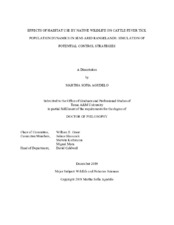| dc.description.abstract | I developed a spatially-explicit, individual-based simulation model, parameterized to represent ecological conditions typical of the south Texas, to examine effects of shifts in habitat use by white-tailed deer (WTD) on the population dynamics of Rhipicephalus (Boophilus) anulatus and R (B) microplus, collectively known as cattle-fever ticks (CFT), and its influence on potential control strategies. At the landscape level, simulated changes in WTD habitat preferences did not seem to have an effect on CFT densities when cattle were present in the system; however, habitat-level differences were observed, especially within mixed-brush habitats. When cattle were present, the role of WTD habitat preferences went largely unnoticed, especially in those habitats more preferred by cattle, suggesting that cattle dominate the system and that there is a spatial scale component influencing the effect of WHT habitat preferences. Similarly, when examining the effect of pasture vacation as a CFT eradication strategy, landscape-level differences in CFT densities were not evident across WTD habitat preferences, while differences were observed at the habitat level, especially within mixed brush, suggesting that there is an interaction between habitat preference and habitat suitability that influences the response of CFT to different host/eradication scenarios at the habitat level.
Densities of CFT in grass, the poor habitat for CFT but preferred habitat by cattle, did not seem as influenced by WTD habitat preferences as by the host/eradication scenario; densities in mixed-brush, the habitat least preferred by cattle and fair for CFT, seemed to be influenced by changes in habitat preference; and densities in mesquite, the best habitat for CFT, constantly supported high densities regardless of host or eradication scenario. Despite consistently supporting the lowest densities of CFT, mixed-brush was the habitat type where the largest differences among habitat preferences were observed, regardless of host/eradication scenario, suggesting that it plays an important role in sustaining CFT populations, with implications for eradication strategies. | en |


